James Kennelly (Ken) Lemmon: Projectionist and Photographer
James Kennelly Lemmon, born in Carlton in 1913, and known to family and friends as Ken, was the second son of Alfred Kennelly Lemmon (Alf) and Ellen Mary Lemmon (nee Moroney). Ken’s paternal Grandfather, Alfred Henry Lemmon had arrived in Melbourne as an unassisted passenger from London in 1865, married Mary Kennelly from Tasmania in Melbourne during 1881, and the couple settled in Madeline Street, Carlton. Ken’s maternal Grandparents, Thomas and Mary Moroney were from Clare, Ireland who had migrated to Melbourne via New Zealand.
Alf and Ellen’s first child, Alfred John Lemmon (Jack), was born in 1911, but six months after Ken was born the family moved from the single fronted, terraced Carlton dwelling into a partly completed house built by Alf at 11 Childers Street, Mentone.
Alf worked as a carpenter in the Victorian Railways, before taking up plastering with the Picton Hopkins building Company between South Yarra and Richmond. He utilised these skills building a few rooms to accommodate his family after purchasing the Mentone block. Extensions were added as the family grew with the arrival of Theresa (Tess), born in the front bedroom in 1914. The house named “Alphenel” was next but one to the sweet shop on the corner of Childers and Rogers (Barkly) Streets, directly opposite the Mentone State Primary School. At the time looking from the Childers Street house back door towards Station Street there was only one other house, the rest was vacant land; north to Warrigal (Moorabbin) Road only one or two houses stood, with vacant land stretching across to Collins and Flinders streets.
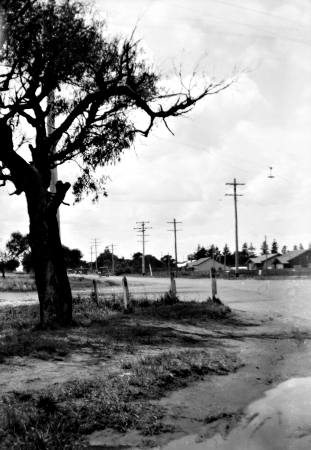
Intersection of Point Nepean Road and Warrigal Road, Mentone, 1928. Photographer Ken Lemmon. Courtesy Paul Lemmon, Kingston Collection.
The two boys, Jack and Ken were students in the original three roomed St. Patrick’s Primary School in Como Parade West, behind the Convent. The school building was the original Mentone Catholic Church, which was converted into a school with a new church built next door. Jack continued his education at St Bede’s, Mentone while a scholarship helped Ken complete his secondary education to Sub-Intermediate (Year 9) at De La Salle, Malvern. He was rather interested in pictures and the mechanics of the theatre, and began a full time electrical course at Royal Melbourne Institute of Technology (RMIT). The course consisted of lectures one day per week combined with home studies to qualify as a Licensed Projectionist. While waiting for an assistant operator vacancy he began work with the Government Printing Office, at about the time movies were in transition from the silent era to sound (‘talkies’). Ken hadn’t started work very long before he bought a box Brownie camera. Alf Lemmon, one of the founding members of the 1925 Mentone Lending Library, was a keen photographer and encouraged his son’s interest.
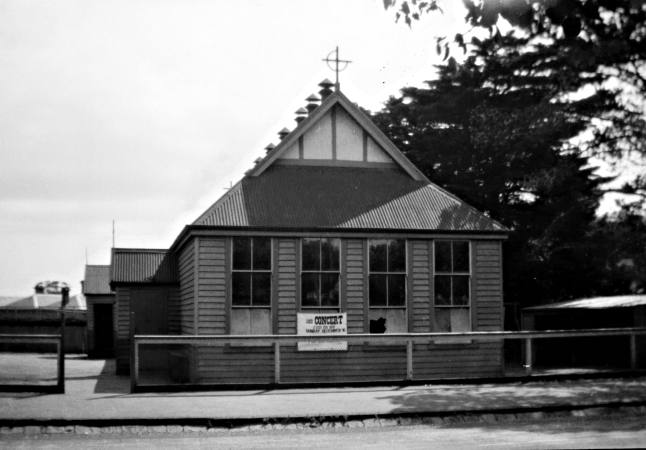
First Catholic Church in Mentone, St Patrick’s Como Parade, Mentone c1928. Later became St Patrick’s Primary School. Photographer Ken Lemmon. Courtesy Paul Lemmon, Kingston Collection.
With the help of a friend, Jim Murphy, Ken decided to have a slide night to aid the fund raising campaign of St Patrick’s Parish and the two friends photographed all they considered of interest around Mentone. Most of the photos were taken on a Sunday morning, when not many others were about as they purposely avoided having people in their shots. Ken purchased the chemicals, processed the negatives, then he and Jim organised the slide show in the original St. Patrick’s school hall. The first half of the viewing displayed their Mentone scenes, while the second half featured slides of Canada with commentary from Ken’s uncle in-law, Ernest Mills. There was a good attendance and £3 was raised.
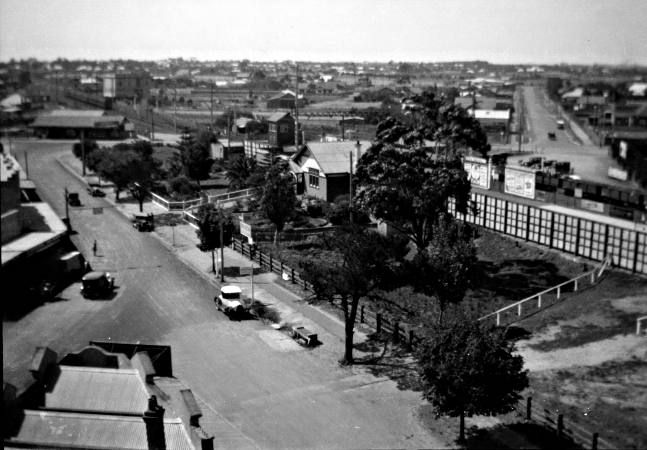
View of Mentone Railway Station. Photograph taken from Kilbreda College Tower, 1928. Photographer Ken Lemmon. Courtesy Paul Lemmon, Kingston Collection.
Still only 16 years old Ken accepted a part time, casual “Assistant Operator” position at the “Austral” theatre, Collingwood; he should have been 18 to work in a theatre. With the help of Andrew Libbis (whose father ran the chemist shop in Mentone Parade) he also picked up a part time projectionist job at the Mentone Town Hall, Brindisi Street; a combined venue for roller skating, dance hall, Council Chambers and local theatre for silent movies three nights per week. The same group of people who ran the original theatre in Brindisi Street also ran the Cheltenham theatre on Point Nepean Road (Nepean Highway). Ken also volunteered to show silent films on a regular basis to staff and patients at the Benevolent Asylum (Kingston Centre), Warrigal Road.
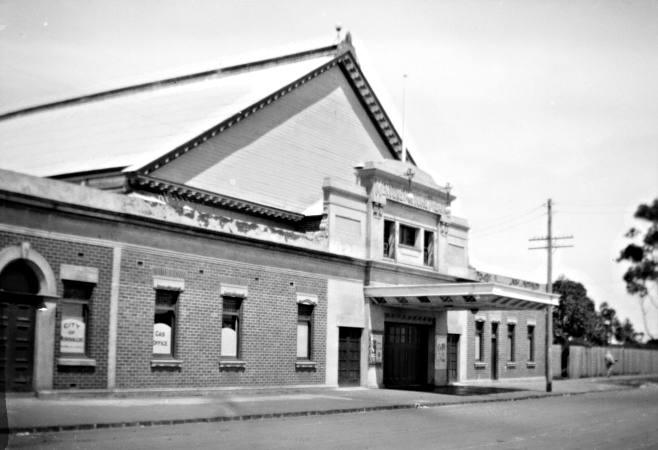
Council Chambers and Skating Rink in Brindisi Street, Mentone. Photographer Ken Lemmon, Courtesy Paul Lemmon, Kingston Collection.
The ‘New Mentone Theatre’ on the Nepean Highway and Balcombe Road corner was built by A Lydford & Sons, where Alf Lemmon and apprenticed son, Jack worked on the interior plastering. The New Theatre opened in the silent movie era with an orchestra below the stage. In 1929 people flocked to this new theatre when electrical equipment for ‘talkies’ movies was installed, and this additional technology together with screenings six nights a week virtually killed off the local Brindisi Street silent movie competition.
Ken was now a part-time assistant with Mr Riordan, who he got to know through their mutual interests, at the ‘Winter Garden’ theatre (Shirley Burke Hall) in Parkers Road, Parkdale. Mr Riordan’s experience and encouragement helped his young assistant successfully complete the RMIT course. The Carr and Fowler group owned both the Winter Garden and Mordialloc theatres, and eventually took over the New Mentone Theatre, when Albert Lydford & Sons ran into financial difficulties following the 1929 crash in financial markets and flow on Depression. The Winter Garden theatre closed, and then reopened as a textile factory during the war.
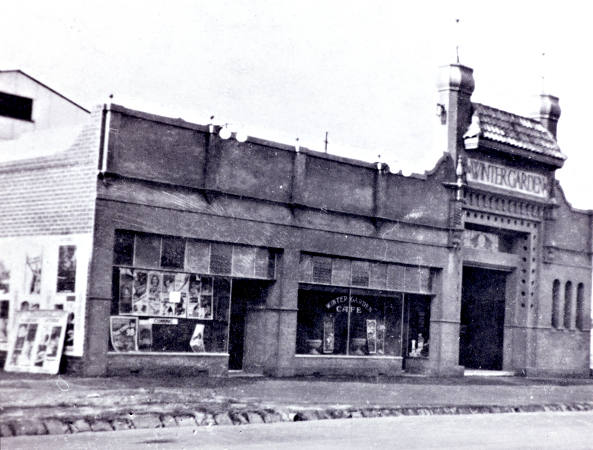
Winter Garden, Parkers Road, Parkdale c1929. Now the Shirley Burke Theatre. Courtesy Mordialloc and District Historical Society.
As a qualified projectionist, Ken took up a full time position in the inner suburbs at the ‘Austral’, Collingwood, and then at ‘The Broadway’ theatre, Camberwell, which also featured the latest ‘talkies’ technology. Hollywood productions struggled in America during the Depression years until the owners realised another country, Australia, had audiences flocking to theatres across the nation. American business groups secured controlling interests in Australian theatre chains, creating new market outlets for their ‘B’ and ‘C’ grade movies, with little interest in local Australian productions. Australian theatres were so controlled that all films dispatched with the latest movie had to be screened, otherwise the Australian chains were denied access to any new Hollywood releases. The fledging Australian film industry struggled for survival under the influence of this outside control. From 1930 - 34 Ken worked at the ‘Melba, Britannia, Hoyt’s Deluxe and Empire’ theatres in Melbourne. The Melba screened four sessions per day between two shifts - two projectionists on each shift, which changed over at 4 pm. Full time employment at ‘The Regal’ theatre, Hartwell provided fifteen years consistent work, and during this time he met Mentone local lass, Edna Fitzgerald. The couple attended the local Sunday night dances held at the St Patrick’s club room, on the corner of Childers and Rogers streets, later demolished to start a new church building in 1957.
Edna attended Mordialloc-Chelsea High School, and then completed Leaving Honours (HSC equivalent) at the University High, Parkville as Mordialloc didn’t offer the higher level. Edna Fitzgerald then commenced her teacher training program, along with two other trainees, which consisted of a three year placements as student teachers at Mentone State School followed by one year in Teachers’ College. Her appointment to Mentone State School No 2950 commenced in February 1935. The Principal’s office and Grades Prep., 1, 2, 3 and 8 were downstairs in the brick building. Upstairs were the staff room and Grades 4, 5, 6 and 7. The school stood opposite St Patrick’s Primary school on the Rogers St side, opposite 11 Childers St, and adjacent to Caudwell’s Timber yard, which extended from Como Parade East to Rodgers Street, with two sides abounding the school fences.
The three trainees received instruction in methods of teaching from 8.30 to 9.00 am twice a week from the head teacher, Mr Grier. Miss Fitzgerald was under the Infant Mistress’s supervision in the Preparatory Class of 5 year olds, who had to be taught the letters of the alphabet and numbers 1 to 10. After three months, these 5 year olds were promoted to Grade 1, and another intake of about thirty beginners filled preparatory class. The second year training was under the supervision of the Grades 3 and 4 teachers, then the following year the upper grades. Student teachers had to prepare and give two class lessons per day, which were critiqued by the class teacher. If there was a teacher absent, student teachers were put in charge of the grade, with the head teacher popping in occasionally to give advice. When not teaching a class, the trainees assisted class teachers by correcting the children’s school work or helping small groups of students. Student teachers were also required to attend and complete various weekly classes at other institutes, such as Caulfield Technical School and Armadale State School. These sessions which included singing, art and sewing, were usually held on Saturday mornings or after school hours. Towards the end of 1937 there was an outbreak of poliomyelitis in Melbourne suburbs and the school was closed for several weeks. The junior teachers delivered correspondence lessons, walking around Mentone, delivering these by hand. The local picture theatres were also closed for Saturday afternoon matinees during the outbreak.
Edna Fitzgerald gained the Trained Primary School Teacher’s Certificate (TPTC) but received no allowance during the final training year. She borrowed £50 pounds from her mother, Maggie to pay fares, books, and travelling expenses to the schools, where she had to do a teaching “round” of two weeks every eight weeks. During these teaching rounds student teachers taught two lessons every day, being critiqued by class teachers, head teacher or college tutor for each lesson presentation. Edna commenced her year at Teachers’ College with a fortnight’s physical training, folk dancing and swimming. She excelled at swimming having gained both junior and senior certificates, and the bronze medallion for lifesaving at Mentone. After Teachers’ College, Edna was bound to the Education Department for three and a half years and was sent to replace rural teachers; single women leaving to get married, or teachers joining the armed forces. Married women were barred from permanent employment with the Education Department at this time, but many were re-employed as temporary teachers during, and following the war years. Ken Lemmon and Edna Fitzgerald became engaged at Christmas, 1939.
At the outbreak of World War 2, Ken was looking to join the Air Force, but peritonitis as a child disqualified him at the medical. More importantly he worked in a protected industry: the Government wanted home morale to be kept high during the war through movies, combined with newsreels of the latest war effort screened across the nation. After Japan attacked Darwin in February, 1942 many Australians built a bomb shelter in their backyards, including Ken’s father on the Childers Street block. Unfortunately after heavy rains in Mentone many low lying areas were flooded because of poor drainage. Consequently heavy rains and water seepage filled Alf Lemmon’s bomb shelter.
As the Mentone Parish had grown, a larger Church was incorporated into the School hall in 1931 as a temporary measure, and remained until the replacement was opened in 1960. So it was in this church / hall that Father Timothy Daly married Ken Lemmon and Edna Fitzgerald on 28 November, 1942. Edna’s brother John gave her away with her sister, Nell as bridesmaid dressed in blue, and Edna pink. The girls didn’t have traditional wedding frocks; war coupons had to be provided for material and clothing, and war coupons were precious. Hence the frocks made by the sisters were suitable for good wearing afterwards.
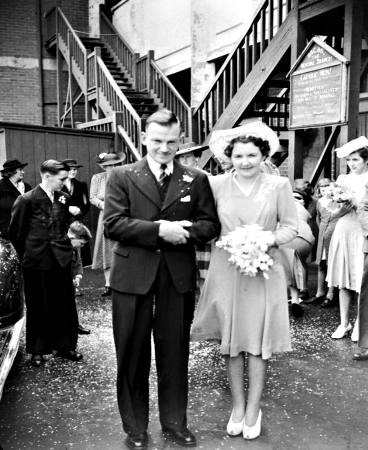
Ken and Edna Lemmon on the occasion of their marriage at St Patrick’s Mentone, November 1942. Courtesy Paul Lemmon.
The young married couple had a wedding breakfast with their immediate family in a small hall on Beach Road, near the Mentone Life Saving Club. Ken owned a Vauxhall Wyvern, which just managed to get the couple to St Andrew’s Hotel on their short honeymoon; not far from Mentone as petrol was limited. They returned to the flat Ken had rented in Hawthorn East, near the Hartwell theatre. Accommodation was very scarce during the War, so they were lucky to get a large front bedroom with a small kitchenette for one pound, seven shillings and sixpence ($2.75) a week. After working for eight months at the Munitions Supplies Laboratory, Maribyrnong, Edna became pregnant and the couple moved to share an 1853 farm house behind the ‘Conara’ property on Prospect Hill Road, Camberwell.
Their first son was born in 1944, followed by twin girls in 1945, only one of whom survived. With the arrival of their third child in 1948, the family had managed to save enough money, when combined with the sale of the Vauxhall, to put down a deposit on a house. But houses were very scarce after the war - especially houses with vacant possession; very few new homes were built until after the war as labour and materials became available.
Fortunately Edna’s mother, Maggie Fitzgerald heard of a nearby farm cottage to be sold on Warrigal Road, across from Johnston Street. The Corrigan family were selling their weatherboard cottage of four rooms, on a large block, 66 by 132 feet on Warrigal Road, and were building a new house near their market gardens in Dingley. The sale was with vacant possession, at the fixed market price - no ‘key money’ required. ‘Key money’ was an unlawful loophole by which a vendor could get two or three hundred pounds ($400 - $600) above the regulated post war fixed price. Many sales were completed only after the unlawful ‘key money’ was paid. Fortunately, Corrigan’s were very honest people.
As the family expanded, Ken continued working at the ‘Regal’ theatre; he caught the Ventura Bus, from the Johnston Street stop on Warrigal Road to Hartwell. He also assisted with the installation of an outside, back-up diesel power unit at the ‘Rivoli’ theatre, Camberwell. When ‘Cinderella’ attended a ball till midnight on the Regal screen in 1951, Ken extended his working day to include relief work at the New Mentone theatre, and became a full time projectionist there in 1953. Wages were better than average given the 30 to 35 hours that included weekends, and he was provided with an assistant at each session. These assistants included several local Mentone and Mordialloc friends; Ken Hunt, Bill Gallagher and Sid Smith.
Ken’s eldest children now had access to the best seats at every Saturday afternoon matinee, overseen from both the projection box and theatre ‘Inside’ staff janitors. Saturday afternoon at the ‘flicks’ proved great entertainment for the youth of Mentone and the district. Long street queues on either side of the main doors signalled the screening of big feature movies – Peter Pan, The Living Desert, Lady and the Tramp, Old Yeller, Sleeping Beauty, Darby O’Gill and the Little People, to name a few in the latter stages before the big decline in attendances. ‘Inside’ and ‘Front of house’ staff were under pressure to get these queues of people inside before the matinee started. When all the stalls, dress circle and lounge were full, patrons were seated to one side of the isles rather than turn any away.
With some access to their father in the projection box, the young theatre goers quickly picked up aspects involved with showing pictures. They observed the preparation, presentation and technical difficulties; learning when, and when not to enter the small projection room. The reels or spools of film were delivered in metal cases to the projection box, via a trolley and dumb waiter from the ground floor. The projection room housed two main ‘Simplex’ projectors, the sound equipment, an adjacent slide room, and a spooling bench. Each of the main projectors had adjustable carbon rods, enclosed in a sealed vapour chamber, and when an electric current arched between the rods, light, heat and fumes were generated. The light shone through the film, as it moved from an overhead spool via sprockets, past the focal lens onto another spool below, and the light streamed the images as flowing motion onto the screen. Fumes generated from the vaporising rods were vented to the outside via a chimney; the projection box entry door was left ajar to create a positive air flow to reduce fume leaks back into the room.
The projectionist adjusted the carbon rods as they vaporised, to maintain the optimum space to produce the bright electrical arc between the rods, which lasted about 20 minutes and roughly corresponded with the time each full spool took to run through the projector. As the last section of film ran past the lens in one projector, a cue ‘spot’ would appear on the cinema screen edge as an indicator to start the next projector. When double spots appeared, the first projector was shut down by closing a set of shutters in front of the lens, and the second projector’s shutter opened to maintain continuity. With an average of 5 - 6 spools per film, the projectionist and assistant operator were busy adjusting and replacing rods, threading up the sequential reel in the ‘idle’ projector, rewinding the just-screened spool, keeping an eye on the screen to maintain focus, and watching for the change-over cues that initiated the switching process between the two machines. The assistant operator presented the local commercials at the start, interval and finish of each show, on three and a quarter inch glass slides as the projectionist prepared the main projectors.
A picture may paint a thousand words, but no picture left the screen black, and theatre patrons in the dark. One obvious solution generally meant replacing the carbon rods, which took a couple of minutes. But when the picture froze on-screen, then bubbled and disappeared, it was a good indicator that film had jammed, and melted from overexposure to heat from the arc. This was a major catastrophe! These film breaks generally created lengthy delays that tested audience tolerance levels, and no amount of stamping feet, or banging seats appeared to encourage the projection staff. Broken film called for delicate splicing on the re-spooling bench, to restore continuity without causing another problem in the film sprockets at the next screening. Projectionists could respond with their own colourful language during these pauses, and the Lemmon children learnt these were not the best moments to sneak into the projection room to ask if ‘Tom and Jerry’ cartoons featured later in the program!
The Robe, released in 1953 was the first cinemascope feature to fill the newly widened Mentone theatre screen, altered outside normal screening hours. A change to the projection lens and aperture completed the process that used the same screen height. When the Mentone curtains rolled back on each occasion to expose the wider screen, thereby announcing the new technology, audible squeals of excitement rose above the theatre patrons.
The three eldest children at Warrigal Rd were a great help as they did the weekly shopping, pushing the goods home in an old pusher, with wheels that were constantly falling off. They brought the groceries at the Cheltenham Co-operative, on the corner of Mentone Parade and Florence Street. A backyard pen, covered with corrugated sheets salvaged from a waste collection, housed chooks that produced either eggs, or a roast dinner and stock. Home grown apricots and Maggie Fitzgerald’s quinces were annually preserved or bottled as jam. Fruit and vegetables were produced from Edna’s vegetable patch, donated by friends and neighbours, or purchased at Mr Passarelli’s fruit shop on Nepean Highway, near the theatre and the bookmaker, Mr Cerato. Milk came home in a billy-can from neighbours, who kept a cow on the fringes of the old Mentone racecourse, used as a training track after its closure in 1948. The race course and the convent paddock were two of the local community bon-fire sites on Guy Fawkes Night. Community interests also took Ken to the Malvern Town Hall where regular singing groups gathered. As the volunteer projectionist, he screened the song lyrics and a moving ball for the audience to follow in time with the band music.
The 1956 Melbourne Olympics marked the introduction of the Television, which had a severe impact on attendances at both city and suburban theatres. Ken attended the Australian Theatre Industry lectures at the Regent that explained how the American model would be followed to overcome the impact of television on audiences. But the uptake and spread of television across the nation overwhelmed the Australian theatre industry. The Inside staff no longer had to hunt free-loaders from the crowd returning after interval; free television shows were now available to everyone at the electrical stores, and people lined the pavements at night to watch through the windows, captivated by the viewing on offer. Newsreels screened at theatres quickly became out-dated as television presented daily news coverage. Theatre screening nights were savagely reduced as television sales rocketed, and as work decreased Ken picked up a part time job at Eric Kilburn’s wood yard on Nepean Highway, Cheltenham. On the corner of Balcombe Road and Nepean Highway the Mentone theatre finally closed in 1961. It became a warehouse, and was then demolished to be replaced with a petrol station. The garage closed and the intersection widened to leave the “Doris Stockton Park”. No mark of recognition for the theatre, its staff and the entertainment provided remained.
Edna managed to get a temporary teaching position in May, 1959, at Highett Primary school in Graham Road. Teachers were in very short supply, as there had been a big baby boom when the war finished; many soldiers returned to civilian life, and women who had been earning money in factories returned to their homes. Now Ken was without a full time job, and took on a temporary work as a barman in the Royal Oak Hotel, Mentone, but was unsuitable for the task. Meanwhile her eldest boys collected empty beer bottles from the Warrigal Road area for extra pocket money, delivering these in the old pram to the ‘Bottle-O’ on the corner of Balcombe Road and Station Street. Ken obtained a permanent job at Joseph Lucas car parts, where the Cheltenham Market was later established, before Southland shopping centre extended across Nepean Highway to include the location. He also accepted a part time offer at the National Theatre, Richmond and managed to continue theatre projection work to supplement the family expenses.
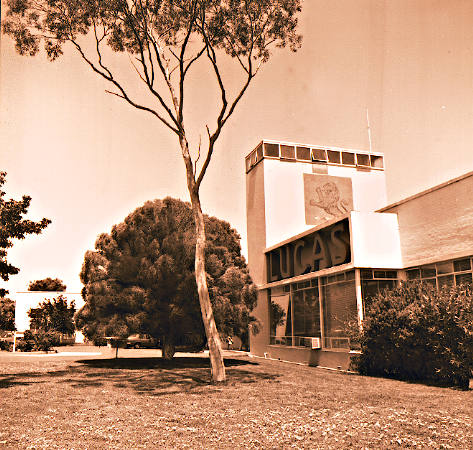
Joseph Lucas Factory, Nepean Highway, Cheltenham 1983. Photographer Bruce Dinan. Courtesy Leader Collection.
In 1960 Edna was transferred from Highett to Cheltenham East Primary School and was later appointed to a permanent position at the new Parktone Primary School. Following several promotions and the gaining of additional qualifications Edna found herself teaching at the primary schools of Mordialloc, Cheltenham and again at Cheltenham East. Her youngest boy now managed the family’s shopping provisions and Edna remained at Cheltenham East until she retired in 1975, when the family had completed their secondary education. In retirement she remained an avid book reader with a “two bob (20 cents) each way” betting interest on any horse ridden by jockey, Harry White.
In 1982 Ken transferred from Joseph Lucas, Cheltenham to the Lucas “Swanston” batteries store in the city, after the parts section closed at Cheltenham. He continued at the city section until he retired from full time work but kept a part-time projectionist interest. Together with his friend Sid Smith, Ken shared part time work screening Continental films at the ‘Paramount’ theatre on Warrigal Road, Oakleigh. With the continued intake of European migrants, the demand for cultural movies grew. Australian television productions were limited in providing different cultural interests, and several Greek businessmen who recognised the need, purchased suburban theatres as they closed, and then presented movies more suited to the growing cultural interests. Ken and Sid screened Greek, Indian, German and Turkish films on Western Electric projectors, learning snippets of these foreign languages as they went. Ken worked at the Paramount for twelve years, undertaking a Greek language course to expand his vocabulary of stories he monitored through the ports in the projection room.
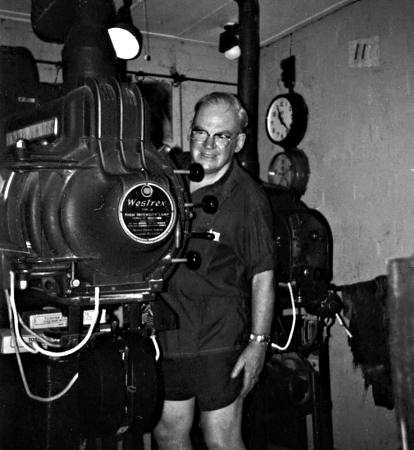
Ken Lemmon, Paramount Theatre Oakleigh. Courtesy Paul Lemmon.
As the St Patrick’s centenary celebrations approached in 1986 parishioners were asked to gather any memorabilia, so Ken looked out his Mentone slides and negatives to reprint the scenes presented at the 1927 slide night. The Centenary memorabilia was gathered together and displayed in the hall – the same venue where Ken and Edna were married. The Centenary participants were impressed and many sought copies of the photos, including the Historical Society. After Edna passed away in 1996, Ken moved into the Kingston Centre as a resident, ironically the same place where he screened silent movies many years before. It was here in 1998 that the final curtain closed on his life. The couple are interned together at the Cheltenham Lawn Cemetery, and Ken’s photographic collection donated to the Historical Society.
